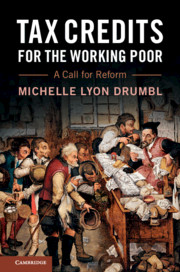Book contents
- Tax Credits for the Working Poor
- Tax Credits for the Working Poor
- Copyright page
- Dedication
- Contents
- Preface and Acknowledgments
- Abbreviations
- Introduction
- 1 A History of the EITC
- 2 Why the United States Uses Lump-Sum Delivery
- 3 How Inexpensive Administration Creates Expensive Challenges
- 4 Importing Ideas
- 5 Reimagining the Credit
- 6 Making a Case for Year-Round EITC Delivery
- 7 Protecting the Antipoverty Element
- 8 Beyond EITC Delivery and Administration
- Index
8 - Beyond EITC Delivery and Administration
How the United States Addresses Poverty
Published online by Cambridge University Press: 24 July 2019
- Tax Credits for the Working Poor
- Tax Credits for the Working Poor
- Copyright page
- Dedication
- Contents
- Preface and Acknowledgments
- Abbreviations
- Introduction
- 1 A History of the EITC
- 2 Why the United States Uses Lump-Sum Delivery
- 3 How Inexpensive Administration Creates Expensive Challenges
- 4 Importing Ideas
- 5 Reimagining the Credit
- 6 Making a Case for Year-Round EITC Delivery
- 7 Protecting the Antipoverty Element
- 8 Beyond EITC Delivery and Administration
- Index
Summary
Chapter 8 delivers a broader critique of how Congress addresses the persistent problem of poverty in the United States. The largest antipoverty program in the United States is conditioned on a work requirement; this chapter pauses to consider whether the Code can also be used to deliver benefits to those who fall through the cracks because they cannot or do not work. The chapter identifies how the changes enacted in the 2017 Tax Cuts and Jobs Act will impact low-income individuals. It closes with thoughts about what Congress is asking of the Internal Revenue Code, and the IRS, by using both as a vehicle for social programs. There are compelling reasons to keep the EITC in the Code and with the IRS; the book concludes with a call for a more thoughtful design of both the credit and the way in which the agency implements it.
- Type
- Chapter
- Information
- Tax Credits for the Working PoorA Call for Reform, pp. 203 - 220Publisher: Cambridge University PressPrint publication year: 2019

